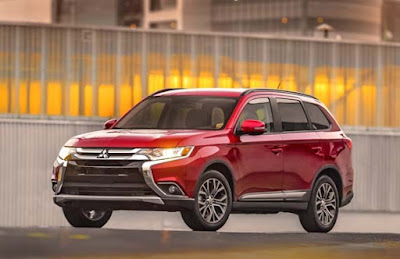When it comes to the Outlander, Mitsubishi has a lot to be proud of. It is the most affordable SUV on the market with three standard rows of seats, has a stellar 10-year/100,000-mile warranty and offers an interesting alternative to models from powerhouses Honda and Toyota. Even better, all of that continues for 2016 as the Outlander receives a significant refresh with more than 100 improvements to the platform, drivetrain, interior and exterior. This makes it a more competitive, more compelling SUV
Redesigned inside and out
The new styling, called "Dynamic Shield," instantly sets the 2016 Outlander apart from the 2015 model, and makes a bold statement. The look may not be for everyone, but it stands out from the rest of the crowd, something that isn't easy to do in such a large, competitive segment. But the styling is far from the most significant change to the Outlander
While both the 2.4-liter I4 and 3.0-liter V6 engines have the same horsepower and torque as before, the 4-cylinder has been revised, and now works with a new continuously variable transmission, the same impressive CVT8 found in the 2015 Mitsubishi Outlander Sport. There is little to no CVT whine and the transmission does an excellent job of matching the power output to what the driver wants. Acceleration is quite good, and the efficient transmission ensures fuel economy of 31 mpg on the highway. The updates to the engine, plus the use of the new transmission, make the I4 feel surprisingly spry, except when going uphill, where you feel the engine's limits. In comparison, even though the V6 has almost 60 more horsepower than the I4, it feels outdated and oddly underpowered. Output through the CVT isn't managed nearly as well as it is with the 4-cylinder. The I4 is going to be the engine that most people get (the V6 is only available on the GT model) and honestly, it's the better choice. Better response, better fuel economy and less expensive to buy, plus it doesn't require premium unleaded gas like the V6
Handling has been noticeably improved for 2016 thanks to reinforcements to the platform that increase rigidity, and new retuned shocks. The downside is the ride is too firm. The Outlander uses electric power steering for 2016, and while it's still numb on-center, steering feel is somewhat improved from last year
The interior is much quieter than before, and uses higher-quality materials, including an attractive accent on the dashboard that resembles tiny pieces of black bamboo. New stitching, nicer materials and an updated steering wheel and navigation system give the interior a fresh, modern feel. In addition, Mitsubishi made the second row much easier to fold flat, with a 1-2-3 strap and lever process (steps 1 and 2 are even labeled), which gives easy access to the tiny third row. The second row's bottom cushion is on the short side, but there's plenty of legroom. Available safety features include adaptive cruise control, lane departure warning, and forward collision mitigation, while seven airbags, hill start assist and more are standard. (The rearview camera is standard on all trims except the base ES
Outlander vs. the Competition
When it comes to the vehicle's size and usage, the Outlander is a bit of a tweener. It's smaller than the Honda Pilot, Toyota Highlander and Dodge Journey, but larger than the Nissan Rogue. It will likely compete against the Rogue and Journey, which have optional third rows, and perhaps the Kia Sorento
With this update, the Outlander is more competitive, but other SUVs provide better fuel economy, better handling and more power. What the 2016 Mitsubishi Outlander has to offer is a capable SUV with a generous cargo area (63.3 cubic feet behind the front row), plenty of standard equipment that's finally on par with the competition and impressive value. In fact, even though there is more standard equipment on the 2016 Outlander than there was in 2015, the base price is $200 lower, bringing the starting price down to $23,845. As a company, Mitsubishi is much smaller than Honda, Toyota and Nissan. Not only does that mean they are capable of making product changes faster, but also that the Outlander doesn't have to be a high-volume SUV to be a success. The improvement Mitsubishi has made to the Outlander is a step in the right direction for both the company and the consumer































0 التعليقات :
Post a Comment